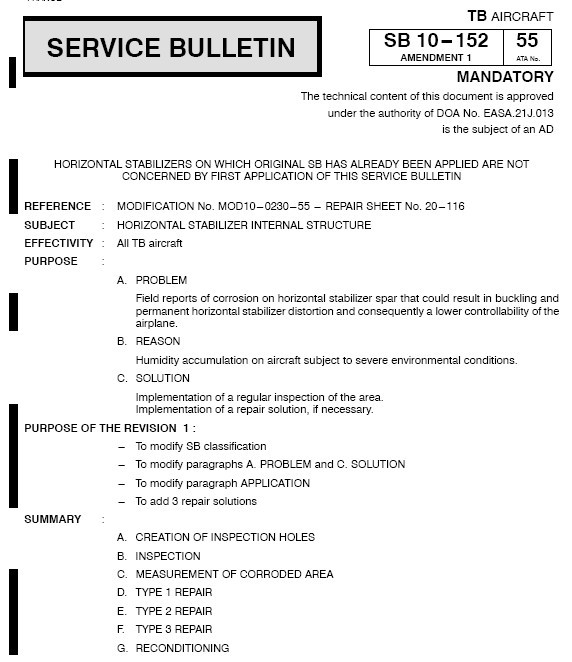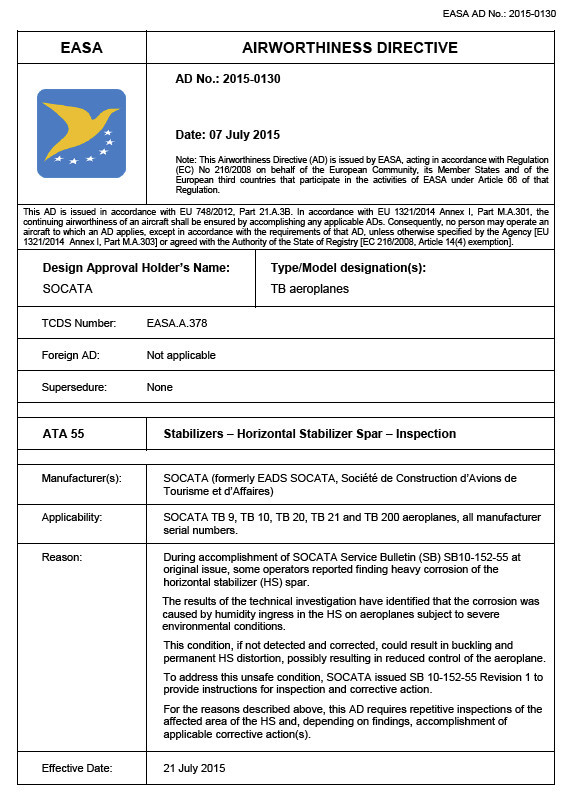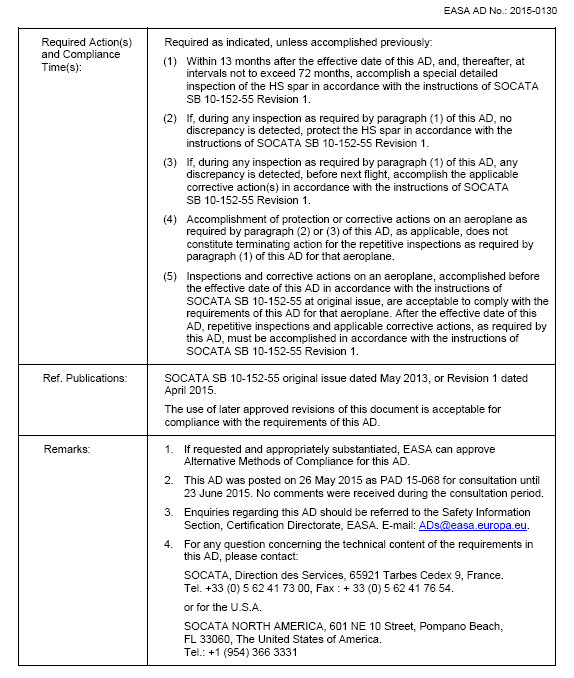This has just come out
REFERENCE : MODIFICATION No. MOD10---0230---55 SUBJECT : HORIZONTAL STABILIZER INTERNAL STRUCTURE EFFECTIVITY : All TB aircraft REASON : A. PROBLEM Field reports of corrosion on horizontal stabilizer spar. B. REASON Humidity accumulation on aircraft subject to severe environmental conditions. C. SOLUTION Implementation of a regular inspection of the area. SUMMARY : A. CREATION OF INSPECTION HOLES B. INSPECTION COMPLIANCE : First application : during the next scheduled inspection. Next applications (Paragraph B. only) : this inspection must be repeated every 6 years.
The possibility of this SB, and a possible resulting AD, has been known for some time, after one TB owner in the USA posted a really worrying report, with pictures, showing massive exfoliation corrosion in a number of TB horizontal stabiliser spars.
The corrosion appeared to have been triggered by the use of stainless steel rivets, in the aluminium spars.
I immediately bought a flexible 6mm x 900mm endoscope (Ebay, £200) and checked mine, as far as one could poke the endoscope inside via the very limited access facilities, and it was clean.
Some others have also checked theirs and found them clean.
Some think it possible that, instead of using the Socata control lock (which fixes the controls in a neutral position and allows water to drain out via some drain holes) the man in the USA was tying his yoke all the way back. This practice is often seen on the UK GA scene, done with elastic band luggage straps. That places the HS in a position from which water may not be able to drain out.
The deeper issue is that a Part 23 aircraft must be visually inspectable for corrosion in essential structures and this component clearly isn't so who in the DGAC signed it off back in the early 1980s?
However I am told that drilling inspection holes is needed in King Airs so this is not unique.
I think the two inspection holes specified in this SB are not going to be sufficient to give a view of the full length of both spars inside the HS - even if they are drilled to the maximum diameter given in the SB of 16mm.
A better procedure would be to drill a hole in each of the end caps ("tip ribs"). Such holes would also allow ACF50 to be effectively sprayed inside the entire HS. Structurally the 2 holes would be trivial but it is a "provocative" sort of thing and getting it backed up by paperwork is desirable. On an N-reg one would get a DER signoff on a drawing - perhaps $300 if you have a good contact.
I proposed that to Socata but instead, months later, they came up with this SB which creates two holes in the bottom.
I have details of the locations of the lightening holes in the HS ribs (and obviously one would align the tip rib holes with those, so both the endoscope and the ACF50 spray nozzle can go all the way through) but I have details only of holes between the two spars. Despite some effort I have not been able to get details of any lightening holes before and after the two spars, and there may not be any. I also tried to contact the man who found this, who said he has access to a number of scrapyard stabilisers (all similarly heavily corroded) but email communication proved to be difficult after the initial contact.
I think "during the next scheduled inspection" means at the next 50hr check, which is more or less immediate.
They might come up with a better solution. :-) Look at the Commander horizontal stabilizer rib inspection AD. You have to derivet the skin, take it apart, inspect it and put it together. (every 150hrs) For the N-reg there is an AMC to do this with a borescope, but EASA failed to adopt this AMC.
This came out this morning.

This is a big job and seems to require de-riveting the skin.
What I don’t get is why they did not instead authorise the drilling of little holes in the tip ribs and then you could use an endoscope to fully inspect the internals.
The previous SB, which came out a few years ago following the discovery of severe corrosion in a number of horizontal stabilisers, authorised the drilling of two inspection holes in the bottom of it but I never thought these were any good because they did not give good access. I also think that the people who got this corrosion were people who had the habit (common in the UK) of securing the controls with a big elastic strap from the yoke to the seat, which places the horizontal stabiliser into an angle at which the drain holes are ineffective. Also these people did not use ACF50 (which to be fair is difficult to get in there, but is possible with the right sort of nozzle).
Presumably EASA-regs will get hit with this in full, regardless of the possibility of a totally satisfactory endoscope inspection.
The earlier SB looked like becoming an AD (FAA and EASA) which would have grounded the entire TB fleet (because there is no way Socata could have made the required number of stabilisers quickly, and they cost about €10k each, inline with the GA industry) but the results from a number of endoscope inspections suggested that the issue was indeed isolated to certain aircraft and IMHO the above dodgy control securing practices.
You already know that your aircraft is not affected and will be like new inside … that’s the bad part, right? I hate SBs like that …
Presumably EASA-regs will get hit with this in full, regardless of the possibility of a totally satisfactory endoscope inspection.
Not unless it becomes an AD or somehow Socata slips it into the maintenance manual.
An opinion has been posted in the Socata owners group that a “mandatory” SB becomes an EASA AD. That’s news to me!
Yes, I had the endoscope check done and found no corrosion, so I am good for 6 years.
There are a million “mandatory” SBs from Cessna and none of them have turned into ADs. It could be well that this one turns into the AD but there is no automatism whatsoever.
And sure enough here is the EASA AD


As mentioned earlier, the corrosion is found in a small % of aircraft, and doesn’t seem to be related to where they were parked (sea, salt, etc). It is quite likely that it is related to the bad practice of tying the controls back to the seat(s) with the roofrack-type elastic bands. That leaves the horizontal stabiliser at an angle at which the drain holes do not work.
Or, it could be a case of batches of defective metal from Socata, which has been blamed by some “close to the action” for the main wing spar corrosion which affected many TB10sin the 1980s, especially.
Peter wrote:
This is a big job and seems to require de-riveting the skin.What I don’t get is why they did not instead authorise the drilling of little holes in the tip ribs and then you could use an endoscope to fully inspect the internals.
It is done the same way they did it for commanders. In US they will develop an AMC with a borescope, but EASA will not allow these AMC to be valid for EASA ADs.
Have fun.